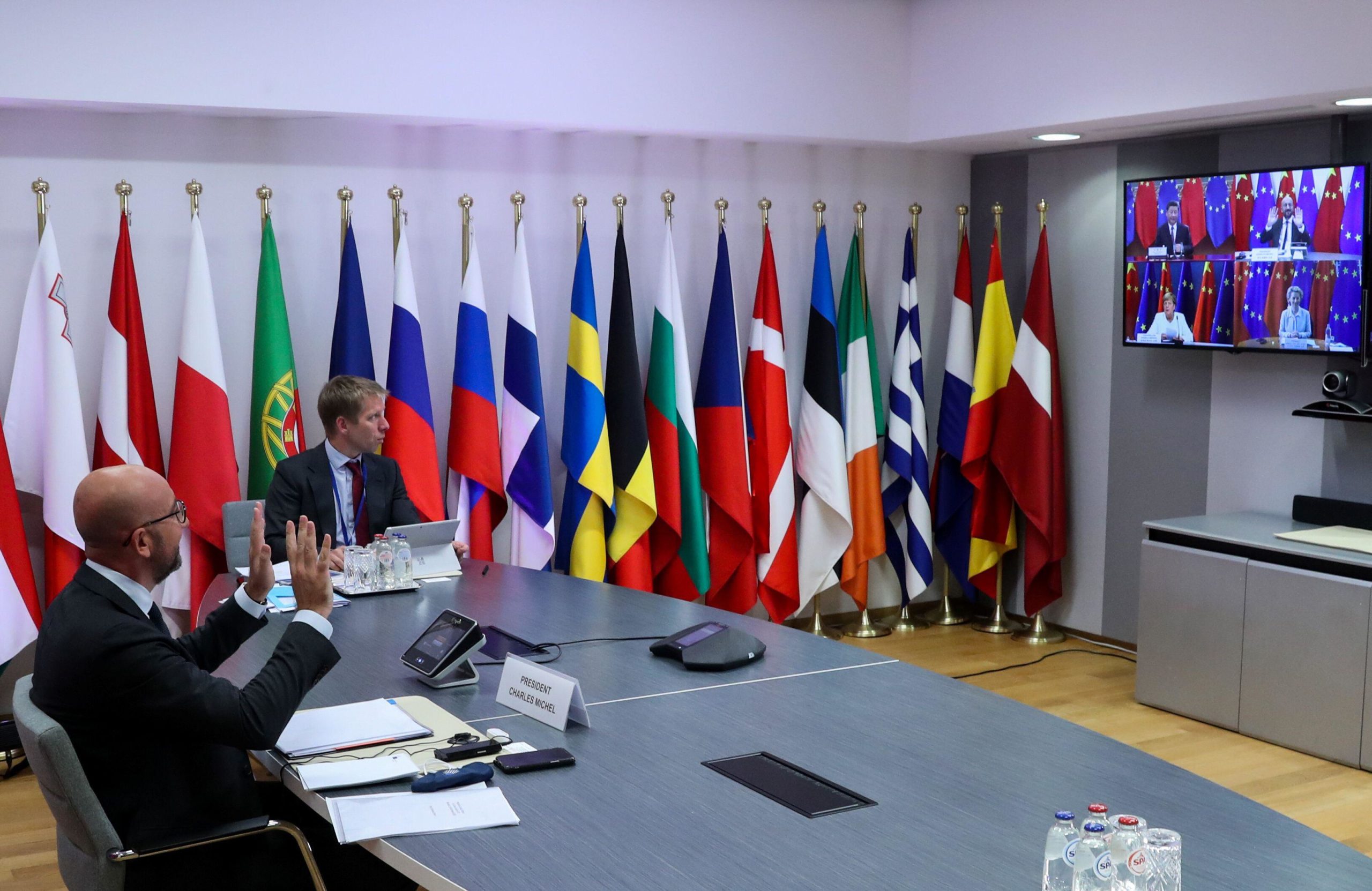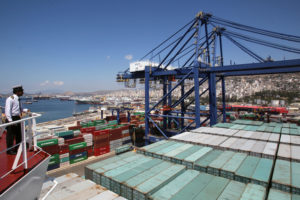After seven years of difficult negotiation, China and the European Union announced in December that a Comprehensive Agreement on Investment (CAI) had been reached “in principle”.
China and the EU after the pandemic
Read more from this series, in which we compare the post-Covid policies of China and the European Union, and how their relationship is evolving
You might expect a strong focus on sustainable development to be at the centre of the agreement. After all, it was reached during a pandemic and following strong statements from both sides favouring ambitious climate action and “building back better”. What better time to rethink and redesign traditional approaches to economic liberalisation?
The European Commission released the CAI draft text in January following multiple requests from policymakers, policy influencers and the public. Many wanted to know whether the deal would yield the benefits both sides have promised. The text allows for a preliminary analysis of where the two parties have applied a sustainable development lens – and where they might have done more.
Market access: How much is gained?
The European Commission boasts that the CAI will give EU investors an “unprecedented level of access” to China, citing broad liberalisation commitments following a “negative list” approach – meaning all sectors are included except those specified.
The EU also highlighted market access commitments in the manufacturing and services sectors. However, the parties have not publicly released detailed schedules and annexes. This makes it difficult to assess how much these commitments go beyond what China has already pledged through its recent domestic reforms in regulating foreign investment.
China adopted its unified Foreign Investment Law (FIL) in 2019 and it came into effect in January 2020. The law takes a pre-establishment negative listing approach similar to the draft CAI provisions. Unless the foreign investors and their investments fall within the specified sectors, the law commits to national treatment and equal protections in their establishment and operation in China (Article 4). The same law also establishes a flexible framework in which experimental policies can be tested, and the scope for further liberalisation has been expanded (Article 13). In this context, the draft CAI seems to provide little improvement for EU investors on their existing access to the Chinese market.
On the other hand, China also praised the provisions of the draft CAI for providing “Chinese business with more transparent and predictable business and legal environment[s].” This may refer to the Regulatory Framework (Section III), where parties agreed to make all investment-related laws and regulations publicly available in a timely manner. Parties also agreed to allow stakeholders opportunities to comment on these laws and regulations, establish contact points to respond to investors’ enquiries, and streamline standard-setting and administrative procedures.

Environment and labour provisions: Room for improvement
Brussels and Beijing both also highlighted the section on sustainability, Section IV. The EU claims this part “includes all of the key elements of the EU approach to sustainable development.” China also considers it to be indicative of the “high-level quality” of the agreement. The current text does not support this satisfaction.
For example, the text recognises the importance of enhancing the contribution of investments to the environment and to combating climate change, but it only commits the parties to facilitate and encourage investment in environmentally or climate-friendly goods and services generally. In so doing, the parties fail to prioritise sustainable investments because the text does not include references to tools such as the EU’s Taxonomy for Sustainable Activities or China’s Green Bond Endorsed Project Catalogue. These would clarify which goods and services are most effective in achieving environmental and climate objectives.
The labour provisions seem even weaker since the draft text does not appear to create new obligations. There is a commitment to pursue the ratification of unratified fundamental International Labour Organization (ILO) conventions, but the CAI allows each party to make “efforts on its own initiative.”
In 2017, the European Commission published a Sustainability Impact Assessment report to assess how the CAI could affect sustainability issues in the EU and China. Among several recommendations, the report said the CAI should include provisions that:
- Retain adequate policy space to protect human rights;
- address private actors’ potential abuse of human rights;
- encourage compliance with international labour, environmental, and human rights standards by EU and Chinese investors; and
- encourage the parties to create a monitoring mechanism focusing on company behaviours.
The CAI’s sustainability section (Section IV) does contain key texts on the parties’ “right to regulate” on environmental and labour issues. At the beginning of the environment and labour sections, the CAI recognises the parties’ right to determine their respective sustainability policies and priorities. This is a clear improvement compared with earlier bilateral investment agreements and reflects more recent international trends. For example, the Canada–EU Comprehensive Economic and Trade Agreement (CETA) contains similar clauses in its investment section (Section 8). The Closer Economic Partner Arrangement (CEPA) between Mainland China and Hong Kong SAR also includes such language.
However, compared to both CETA and CEPA, the CAI’s “right to regulate” clauses are narrowly focused on environmental and labour issues. CEPA affirms that parties are allowed to take regulatory action to protect the “public interest,” while under CETA, the text affirms that parties have broader rights to make environmental, social, safety, public health, and consumer protection regulations.
The CAI sets a low threshold for environment protection regulations. The text does not require parties to provide high levels of environmental protection and only allows them to regulate in accordance with their domestic laws and international treaty commitments. No new obligations are therefore created. Moreover, the “levels of protection” article (Section 4, sub-section 2, Article 2) is aimed more at preventing a race to the bottom (ie, where governments attract investment by watering down existing regulations) than levelling the playing field between the EU and China on environmental regulations.
The draft text contains a sustainability impact review article that provides opportunities for parties to assess the sustainability impacts from the CAI’s implementation. Ex-ante (prior) environmental assessments for trade and investment agreements have been a common international practice. Since 2012, the EU has carried out multiple ex-post assessments of environmental and social impacts for its trade agreements. Six of these ex-post evaluations have been completed and another five are in process. So far, there is no publicly available information on how such evaluations affect an agreement’s implementation.
The CAI agreement, in principle, is still subject to further technical and legal work, which could mean some revisions to the text. There is still a long way to go before signature and ratification. Publicly, the EU has referred to the CAI only as an “agreement in principle”, indicating space for further negotiations. For context, CETA reached an “agreement in principle” in October 2013, but negotiations only concluded in August 2014. It was formally signed in October 2016.
New developments may also emerge in the implementation phase once the agreement enters into force. However, the failure to incorporate stronger environment and labour elements, especially the 2017 EU Commission recommendations, means the current deal is a missed opportunity for both parties to maximise investments in sustainable development, and at a time when a sustainable and resilient recovery is one of the top priorities for governments around the world. In addition, in February, the European Commission published its new trade and sustainability strategy. It will be interesting to see how the final text of the CAI and its implementation will align with the ambitions set out in that document.
The article is an expansion from an earlier blog version. The author would like to thank Nathalie Bernasconi-Osterwalder and Sofia Baliño for their valuable comments on earlier drafts.









![Indian father riding on at electric three wheeler with his child [image: Suman Kumar / Alamy]](https://dialogue.earth/content/uploads/2021/05/2BHEFB6-300x200.jpg)